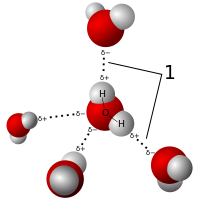
Photo from wikipedia
Poly (vinyl alcohol) (PVA)-based solid polymer electrolytes doped with ammonium thiocyanate (NH4SCN) and glycerol were fabricated using a solution casting method. Lithium-based energy storage devices are not environmentally friendly materials,… Click to show full abstract
Poly (vinyl alcohol) (PVA)-based solid polymer electrolytes doped with ammonium thiocyanate (NH4SCN) and glycerol were fabricated using a solution casting method. Lithium-based energy storage devices are not environmentally friendly materials, and they are toxic. Thus, proton-conducting materials were used in this work as they are harmless and are smaller than lithium. The interaction between PVA and the electrolyte elements was shown by FTIR analysis. The highest conductivity of 1.82 × 10−5 S cm−1 was obtained by the highest-conducting plasticized system (PSP_2) at room temperature. The mobility, diffusion coefficient, and number density of anions and cations were found to increase with increasing glycerol. FESEM was used to investigate the influence of glycerol on film morphology. TNM showed that the cations and anions were the main charge carriers. LSV showed that the electrochemical stability window of the PSP_2 system was 1.99 V. The PSP_2 system was applied in the preparation of an electrical double layer capacitor device. The shape of the cyclic voltammetry (CV) curve was nearly rectangular with no Faradaic peaks. From the galvanostatic charge-discharge analysis, the power density, energy density, and specific capacitance values were nearly constant beyond the first cycle at 318.73 W/Kg, 2.06 Wh/Kg, and 18.30 F g−1, respectively, for 450 cycles.
Journal Title: Membranes
Year Published: 2021
Link to full text (if available)
Share on Social Media: Sign Up to like & get
recommendations!